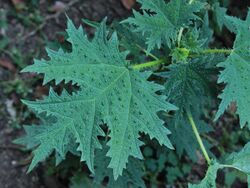Biology:Girardinia diversifolia
| Girardinia diversifolia | |
|---|---|

| |
| Scientific classification | |
| Kingdom: | Plantae |
| Clade: | Tracheophytes |
| Clade: | Angiosperms |
| Clade: | Eudicots |
| Clade: | Rosids |
| Order: | Rosales |
| Family: | Urticaceae |
| Genus: | Girardinia |
| Species: | G. diversifolia
|
| Binomial name | |
| Girardinia diversifolia (Link) Friis
| |
| Synonyms[1] | |
| |
Girardinia diversifolia, commonly known as the Himalayan nettle[2] or Nilghiri nettle,[3] is a plant species native to Nepal and in the Himalayan parts of India such as Uttarakhand, Himachal Pradesh and Jammu and Kashmir and in vast parts of China .[4] It grows naturally at elevations between 1,200 to 3,000 metres (3,900 to 9,800 feet). It is a shade tolerant, tall, stout and erect herb growing up to 3m height with perennial rootstock. The plant grows as a clump, and each clump has many stems. The stem contains bast fiber of unique quality which is strong, smooth and light.[5]
Description
It is a 1.5 to 3 metres tall[6] perennial herbaceous shrub that grows without cultivation all over Nepal.[7] It most frequently occurs in the hilly and mountainous regions at altitudes up to 3000 m.[8]
Vernacular names
The plant is locally known as:
- Sisaun in Kumauni language
- Kandaali in Garhwali language
- 'Nepalese allo
- "Kungs" in Kullu district of Himachal Pradesh
- "Thurche" in Badugu language in the Nilgiris district
Uses
Traditional users of Allo are ethnic groups from across Nepal, including the Kulung, Gurung, Magar, Rai and Tamang people.[9] Allo products are culturally important to both the Gurung[9] and the Rai.[8] It is also sold for commercial and non-religious purposes.[7] Non-fibre uses of the plant range from fodder and fuel wood,[8] to use as a live fence and in traditional medicines.[9] Allo fibre is very flexible and has high tenacity,[10] allowing it to be used in a multitude of applications ranging from clothing and bags to floor mats and rope.[9][11][12] Fibres made from allo are fully biodegradable.[10]
Gallery
References
- ↑ "The Plant List: A Working List of All Plant Species". http://www.theplantlist.org/tpl1.1/search?q=Girardinia+diversifolia.
- ↑ {{citation | mode = cs1 | title = Girardinia diversifolia | work = Germplasm Resources Information Network (GRIN) | url = | publisher = [[Organization:Agricultural Research ServAgricultural Research Service (ARS), United States Department of Agriculture (USDA) | access-date = 4 September 2015 }}
- ↑ (xls) BSBI List 2007, Botanical Society of Britain and Ireland, https://bsbi.org/download/3542/, retrieved 2014-10-17
- ↑ url=
- ↑ Assessment of Allo Production and Enterprise Potential in Parbat District
- ↑ Singh, S.C.; Shrestha, R (1988). "Girardinia diversifolia (Urticaceae), a non-conventional fiber resource in nepal". Economic Botany 42 (3): 445–447. doi:10.1007/BF02860167.
- ↑ Jump up to: 7.0 7.1 Dunsmore, J (1998). "Microenterprise development: Traditional skills and the reduction of poverty in highland nepal". Himalaya, the Journal of the Association for Nepal and Himalayan Studies 18 (2): 22–27.
- ↑ Jump up to: 8.0 8.1 8.2 Barakoti, T; Shrestha, K (2008). "Commercial utilization of allo (Girardinia diversifolia) by the rais of sankhuwasabha for income generation". Banko Janakari 18 (1): 18–24. doi:10.3126/banko.v18i1.2162.
- ↑ Jump up to: 9.0 9.1 9.2 9.3 Gurung, A; Flanigan, H; Kumar Ghimeray, A; Karki, R; Bista, R; Gurung, O.P. (2012). "Traditional knowledge of processing and use of the himalayan giant nettle (Girardinia diversifolia (Link) Friis) among the Gurungs of Sikles, Nepal". Ethnobotany Research and Applications 10: 167–174. doi:10.17348/era.10.0.167-174. http://journals.sfu.ca/era/index.php/era/article/view/622/403.
- ↑ Jump up to: 10.0 10.1 Bajpai, P.K.; Meena, D; Vatsa, S; Singh, I (2013). "Tensile behavior of nettle fiber composites exposed to various environments". Journal of Natural Fibers 10 (3): 244–256. doi:10.1080/15440478.2013.791912.
- ↑ Shrestha, R (1999). "Improvements on the traditional harvesting practice of girardinia diversifolia". Tropical Agriculture Research and Extension 2 (1): 74–75.
- ↑ Dunsmore, J (1998). "Crafts, cash and conservation in highland nepal". Community Development Journal 33 (1): 49–56. doi:10.1093/cdj/33.1.49.
Wikidata ☰ Q130231 entry
 |









